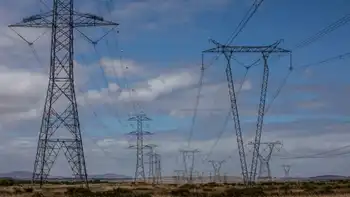Canada could become a growing energy power
But it turns out ethanol was just the first sprout in all the energy-creation possibilities growing out of Canada's farms and forests.
The third annual Growing the Margins convention in London, Ontario showcased all the new technologies that could turn Canada, in the words of one industry leader, into the "Saudi Arabia of biomass energy."
In recent years, there's been a surge in the construction of corn-based ethanol plants, including one opened recently in Aylmer.
But Douglas Bradley, president of the Canadian Bioenergy Association, said the future lies with new technologies, such as biogas, bio-oil, biomass and cellulose-based ethanol.
Bradley said corn-based ethanol has been dogged by the food vs. fuel controversy and the province of Quebec has banned production of ethanol from corn meal.
He said corn-based ethanol plants are still viable and the concern about displacing food production is "uninformed." Bradley also said the new ethanol plants would use other sources.
"We have seen the last of the plants that will produce corn-based ethanol."
Bradley said the European Union is racing ahead of North America in developing smaller, community-based power generation based on renewable energy. He said there's great potential to build community heat and power projects in North America using various forms of biomass energy.
But "ancient" regulations are a roadblock to developing the projects or even importing European technology, he said.
For example, Ontario required all boilers in excess 1.5 megawatts to be supervised by a steam engineer on site at all times.
"This rule alone craters the economics for all small- to medium-sized heat and power projects," he said.
In Europe, boiler safety is handled by alarm systems and periodic inspections.
John McMullen, chairperson of the Growing the Margins conference, said rural Southwestern Ontario is in a great position to become a centre for green energy.
Environmental concerns and renewed political interest has spurred in renewable energy research and projects, he said.
"Things are ramping up quickly."
Waste wood from the forest industry could be a rich source of energy for wood pellets and cellulose-based ethanol.
Bradley said waste from lumber mills has been accumulating in eastern Canada for 30 years because the mills were not allowed to burn the scrap and sawdust.
"We literally have mountains of biomass sitting all across Ontario and Quebec," he said.
Wood pellets can be used in boilers to replace coal and other fuels. Last year, Canada replaced Sweden as the world's leading wood pellet producer.
The European Union uses wood pellets in district power plants. Bradley said the EU is ramping up to meet renewable energy targets: "They want as many wood pellets as we can possibly send."
While Canada's market for wood pellets is still small, Ontario Power Generation is considering replacing coal with wood pellets in its Nanticoke plant because the pellets emit much less greenhouse gas.
Researchers at the University of Guelph are working on a system to plant rows of fast-growing willow and poplar trees between rows of crops to produce wood pellets that could be burned to heat buildings.
Researcher Naresh Trevathasan said it's an ideal solution for marginal land along Lake Erie where tobacco was once grown. The area also has a number of greenhouse operations that could lower their energy costs by burning the pellets.
He said willows grow so quickly that cuttings can be harvested every three years, and the trees will continue to grow for 20 years.
Planting between rows of soybeans and wheat actually enhances crop yields.
Several Canadian companies are world leaders in biofuel production. A process called fast pyrolysis converts materials such as wood chips or farm waste into liquid fuel that can be used to heat buildings.
Vancouver-based Dynamotive Energy Systems has a plant in West Lorne that converts sawdust from Erie Flooring and Wood into biofuel to replace natural gas in a 2.5-megawatt turbine that feeds power into the Ontario grid.
The Stanton family dairy farm north of London is the site of a showcase biogas plant that will use manure and food-processing waste to generate methane.
That methane will fuel a generating plant that could feed as much as 1.3 megawatts of electricity into the provincial grid, enough to power neighbouring Ilderton.
But progress in getting the plant running has been slow as the Stantons ran into bureaucratic and economic barriers working with Ontario's renewable energy program.
Garry Fortune, a consultant working with the Stantons, said the electrical grid in rural Ontario is not designed to receive power generated by small on-farm plants.
He said the Stantons also were expected to pay the full cost of hooking their plant up to the grid, while only receiving 11 cents for every kilowatt hour of power they produce.
"As a small generator, you are still treated the same as the Bruce Nuclear plant," he said.
Fortune hopes Ontario's new Green Energy Act will remove some barriers. He expects the province soon will overhaul rules for renewable energy products to recognize biogas's higher development costs.
"Different technologies warrant different rate structures," said Fortune. "On-farm biogas has so many benefits that were not taken into account when the system was set up."
The Stanton project has connected to the grid and is waiting for the reforms to be announced before signing a formal deal with the province, he added.
Don Nott of Clinton says a switch to switchgrass could give Ontario farmers a promising, environmentally-friendly crop.
Nott grows 131 hectares of the hardy perennial on his farm and works a Walkerton company to turn it into pellets.
Nott said switchgrass in bales or pellets can be used to heat homes in rural Ontario. It burns cleanly and it's cheaper than furnace oil or propane.
"There's a huge market for an efficient, clean-burning pellet furnace," he said.
Nott said switchgrass grows swiftly to a height of more than two metres with minimal fertilizer. It can be easily substitute for hay in rotation with other crops.
Nott said growers need government help in setting up a small demonstration plant that could develop the most efficient system for pelletizing switchgrass.
Research continues at the University of Guelph to turn crops such as corn and soybeans into basic manufacturing materials such as plastic, rubber, and fibre panels.
The home-grown new materials could not only replace petroleum products such as car parts, but their quality and strength could be improved and the material would be biodegradable, researchers say.
Related News

Tunisia moves ahead with smart electricity grid
TUNIS - The Tunisian parliament has approved taking a $131.7 million loan from the French Development Agency for the implementation of a smart grid project.
Parliament passed legislation regarding the 400 million dinar ($131.7 million) loan plus a grant of $1.1 million.
The loan, to be repaid over 20 years with a grace period of up to 7 years, is part of the Tunisian government’s efforts to establish a strategy of energy switching aimed at reducing costs and enhancing operational efficiency.
The move to the smart grid had been postponed after the Tunisian Company of Electricity and Gas (STEG) announced in March 2017…




